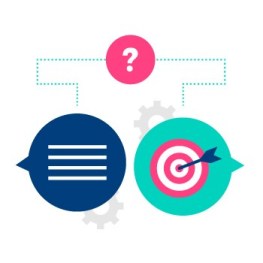A 4-Step Sales Process to Streamline Your Deal Flow
Without a clearly defined sales process, your reps will struggle to hit quota. Here’s a simple, 4-step process proven to grow a business by 20-30%/month.
Plenty of companies struggle to reach their sales objectives. They either have prospects that take forever to close or, worse, never close at all.
When you look closer, this is usually due to not having a clearly-defined sales process in place. In a rush to make those first sales, many small companies never take the time to structure their process, while larger companies often have problems coordinating between different departments.
Fortunately, it’s easy to put a sales process in place — one that everyone on your team will be able to follow.
Keep reading to learn the simple, 4-step process we use at Belkins to grow our own business by 20–30% every single month, while also being able to deliver an ROI of 7:1 for our clients.
Here’s what it looks like.
Step 1: Research

The first part of our sales process is the one most people either rush or skip entirely, inadvertently setting up their sales for failure.
Don’t rush this step! Taking the time to thoroughly research your prospects is the best thing you can do to close more sales.
How do you research a sales opportunity? Let’s break this step into three stages:
Creating and Using an ICP
Our first step, whether it’s for ourselves or for our clients, is to create an Ideal Customer Profile (ICP). While you may take it for granted that you know who your ideal customers are, the process of creating an ICP gives you a laser focus and can uncover new insights for your sales campaign.
It’s critical to know who you’re contacting and why.
At its most basic, your ICP will be a fictional company (based on real data) that:
- Represents companies who both offer you great value (in terms of revenue, influence, etc.) AND
- Receive great value from you (usually in terms of ROI, improved service, etc.).
You can get an idea of what goes into an ICP by taking our online questionnaire.
Identifying Potential Leads
Once you have an ICP to work from, you can begin generating a database of potential leads who match that profile.
Finding those companies will depend on your specific requirements, but possibilities include social media (such as LinkedIn) and online databases (such as Crunchbase).
When you find those ideal companies, compile a list of the individual prospects at those companies for your sales team to contact and qualify.
Initial Qualification
Even when working from the best ICP, you’ll still need to qualify your individual prospects. We’ve written an in-depth guide if you’re curious, but in short, you’ll want to look for four key factors:
- Need
- Budget
- Authority
- Timing of Need
You can then look into additional qualifiers depending on your unique requirements, such as company size, growth, geography, and so on.
While you may need to speak directly with your prospect to fully qualify them, you can usually get a good indicator of these factors during your initial research phase.
Step 2: Outreach
Once you have a clear picture of your prospect, you’re ready to reach out and make contact. We break this down into two distinct steps:
Identifying the Best Method
What’s the best way to get hold of your prospects? Maybe they’re particularly active on a specific social network, or they’re only reachable by phone. Maybe cold email is the best method, or an old-school postcard is needed to stand out from the competition.
More than likely, you will use a combination of methods.
For example, you might interact with them on social media, send an email, then follow-up with a phone call. Either way, you have to remember to use the method that’s best for your client.
You may love reaching out with connection requests on LinkedIn, but if your contact is inactive, doesn’t respond to connection requests, or isn’t even on the platform, even the most original, clever outreach message may as well be smoke signals.
Execution
They say you only get one chance to make a good first impression. So, no pressure.
When you finally reach out, it’s important to have your objective clearly in mind. In most cases, this will not be making a sale. After all, would you buy anything off a complete stranger on the internet?
The higher your price point, the less likely someone is to buy from an initial outreach, whatever its form. Instead, use your outreach to introduce yourself, to build trust, and ultimately start a conversation. The sale comes later.
Step 3: Engagement

I’m sorry to break it to you, but sales takes more than just one email or phone call. Your initial outreach gets the conversation started. Ongoing engagement creates a relationship.
As you engage with your prospect, you have three objectives:
Further Qualifying the Prospect
Once you’ve opened the lines of communication, you have a great opportunity to get to know your prospect properly. This includes learning about their specific needs and seeing if you’re genuinely a good fit for each other. This should include identifying opportunities where you can offer high value (as per your ICP).
It’s also a chance to further qualify them as a prospect and confirm whether they meet those four key criteria (see above).
Talking directly with a prospect is the best (and often only) way to be certain they are the right prospect for you.
Handling Objections
While you’re qualifying your prospect, they’re also qualifying you. They need to build a certain level of trust in you before they feel comfortable moving on to the next step.
To do that, you’ll often need to address some objections. Sometimes though, these objections won’t be explicitly stated, meaning you’ll need to learn to read between the lines.
“We’re not interested” might mean they’ve tried similar services before and been let down — and are worried about that happening again.
Familiarizing yourself with general objections will help. But to get to the real root of the objection, you’ll often have to ask more questions. Once you’ve asked a question, remember to listen carefully to their answer rather than preparing what you’re going to say next.
Nurturing Prospects
Even without objections, most prospects will need some kind of nurture sequence. For example, you’ll likely need to move them along the stages of awareness, from pain aware to most aware.
You’ll still need to build trust, and the best way to do that is offer consistent value.
In addition, you will likely come across prospects who are interested and otherwise qualified, but for whatever reason aren’t ready to sign up right now.
In this case, it’s important to maintain regular contact — again offering valuable help — to stay top of mind. When they are ready to buy, you’ll be the first person they think of.
Step 4: Closing
It’s time for all that hard work to pay off as we reach the culmination of the sales process — actually making the sale.
Sealing the Deal
If the prospect matches your ICP, you’ve reached out in a way that suits them, and you’ve demonstrated value, then hopefully they’ll be eager to buy.
You should never feel the need to “trick” them into buying, but even a perfect prospect may require a nudge before making their decision. You can’t rely on them closing themselves.
The key is to make it easy for them to say yes.
There are a number of different possibilities, ranging from indirect (“Are you happy with the features in this particular package?”) to the direct (“Would you like to go ahead and sign up now?”).
You can also introduce other factors, such as:
- Urgency/scarcity (“The price goes up at midnight”)
- Offering incentives
- Including a free trial (“Why not try it out for a week and see how you get on?”)
For example, here at Belkins, we are very confident in our ability to consistently deliver qualified leads to our clients over time. That’s why, unlike other Lead Generation agencies, we don’t lock companies in with a minimum engagement period of three or six months, allowing them to pay as they go month-by-month. This policy allows us to close more business than our competitors since clients don’t feel obligated to a long-term contract from the first month.
If, after all this, the prospect still seems hesitant, it’s often best to simply ask them what else they’d need to know to make a decision.
Follow-Up
Finally, even with your best efforts, factors outside your (or the prospect’s) control may mean the answer is “Not yet.”
n this case, the best thing you can do is add them to a nurture campaign (see above), regularly following up with any prospects who aren’t yet ready to say yes.
You could also use this as an opportunity to reach out to additional contacts within the same company.
Conclusion
It may seem like extra work, but taking the time to establish a clear and well-defined sales process offers many benefits.
You can easily check all steps have been followed, see where there are ”holes” in the funnel, and measure your success rate.
By making research, outreach, engagement, and closing all part of your process, you can focus on finding better customers and closing more sales.
Does your organization use a similar sales process? How closely do you follow the 4 steps outlined above? Let us know in the comments below:






No comments yet.